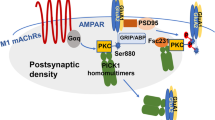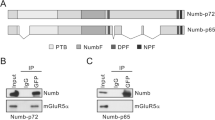Abstract
In this study, we tested the hypothesis that the elongation 1A (eEF1A) family regulates the cell surface density of the M4 subtype of the muscarinic acetylcholine receptors (mAChR) following agonist-induced internalization. Here, we show that mouse brains lacking eEF1A2 have no detectable changes in M4 expression or localization. We, however, did discover that eEF1A1, the other eEF1A isoform, is expressed in adult neurons contrary to previous reports. This novel finding suggested that the lack of change in M4 expression and distribution in brains lacking eEF1A2 might be due to compensatory effects of eEF1A1. Supporting this theory, we demonstrate that the overexpression of either eEF1A1 or eEF1A2 inhibits M4 recovery to the cell surface after agonist-induced internalization in PC12 cells. Furthermore, eEF1A1 or eEF1A2 had no effect on the recovery of the M1 subtype in PC12 cells. These results demonstrate the novel ability of the eEF1A family to specifically regulate the M4 mAChR.









Similar content being viewed by others
References
Sugden PH, Clerk A (1997) Regulation of the ERK subgroup of MAP kinase cascades through G protein-coupled receptors. Cell Signal 9(5):337–351
Gutkind JS (1998) The pathways connecting G protein-coupled receptors to the nucleus through divergent mitogen-activated protein kinase cascades. J Biol Chem 273(4):1839–1842
Levey AI, Kitt CA, Simonds WF, Price DL, Brann MR (1991) Identification and localization of muscarinic acetylcholine receptor proteins in brain with subtype-specific antibodies. J Neurosci 11(10):3218–3226
Flynn DD, Ferrari-DiLeo G, Mash DC, Levey AI (1995) Differential regulation of molecular subtypes of muscarinic receptors in Alzheimer’s disease. J Neurochem 64(4):1888–1891
Mrzljak L, Levey AI, Goldman-Rakic PS (1993) Association of m1 and m2 muscarinic receptor proteins with asymmetric synapses in the primate cerebral cortex: morphological evidence for cholinergic modulation of excitatory neurotransmission. Proc Natl Acad Sci USA 90(11):5194–5198
Liebmann C, Bohmer FD (2000) Signal transduction pathways of G protein-coupled receptors and their cross-talk with receptor tyrosine kinases: lessons from bradykinin signaling. Curr Med Chem 7(9):911–943
Nathanson NM (2000) A multiplicity of muscarinic mechanisms: enough signaling pathways to take your breath away. Proc Natl Acad Sci USA 97(12):6245–6247
Ferguson SS (2001) Evolving concepts in G protein-coupled receptor endocytosis: the role in receptor desensitization and signaling. Pharmacol Rev 53(1):1–24
Bernard V, Laribi O, Levey AI, Bloch B (1998) Subcellular redistribution of m2 muscarinic acetylcholine receptors in striatal interneurons in vivo after acute cholinergic stimulation. J Neurosci 18(23):10207–10218
Wess J (2004) Muscarinic acetylcholine receptor knockout mice: novel phenotypes and clinical implications. Annu Rev Pharmacol Toxicol 44:423–450
Nadler LS, Rosoff ML, Hamilton SE, Kalaydjian AE, McKinnon LA, Nathanson NM (1999) Molecular analysis of the regulation of muscarinic receptor expression and function. Life Sci 64(6–7):375–379
McClatchy DB, Knudsen CR, Clark BF, Kahn RA, Hall RA, Levey AI (2002) Novel interaction between the M4 muscarinic acetylcholine receptor and elongation factor 1A2. J Biol Chem 277(32):29268–29274
Chambers DM, Peters J, Abbott CM (1998) The lethal mutation of the mouse wasted (wst) is a deletion that abolishes expression of a tissue-specific isoform of translation elongation factor 1alpha, encoded by the Eef1a2 gene. Proc Natl Acad Sci USA 95(8):4463–4468
Negrutskii BS, El’skaya AV (1998) Eukaryotic translation elongation factor 1 alpha: structure, expression, functions, and possible role in aminoacyl-tRNA channeling. Prog Nucleic Acid Res Mol Biol 60:47–78
Edmonds BT (1993) ABP50: an actin-binding elongation factor 1 alpha from Dictyostelium discoideum. J Cell Biochem 52(2):134–139
Liu G, Tang J, Edmonds BT, Murray J, Levin S, Condeelis J (1996) F-actin sequesters elongation factor 1alpha from interaction with aminoacyl-tRNA in a pH-dependent reaction. J Cell Biol 135(4):953–963
Edmonds BT, Murray J, Condeelis J (1995) pH regulation of the F-actin binding properties of Dictyostelium elongation factor 1 alpha. J Biol Chem 270(25):15222–15230
Kurasawa Y, Watanabe Y, Numata O (1996) Characterization of F-actin bundling activity of Tetrahymena elongation factor 1 alpha investigated with rabbit skeletal muscle actin. Zoolog Sci 13(3):371–375
Murray JW, Edmonds BT, Liu G, Condeelis J (1996) Bundling of actin filaments by elongation factor 1 alpha inhibits polymerization at filament ends. J Cell Biol 135(5):1309–1321
Liu G, Grant WM, Persky D, Latham VM Jr, Singer RH, Condeelis J (2002) Interactions of elongation factor 1alpha with F-actin and beta-actin mRNA: implications for anchoring mRNA in cell protrusions. Mol Biol Cell 13(2):579–592
Van Koppen CJ, Sell A, Lenz W, Jakobs KH (1994) Deletion analysis of the m4 muscarinic acetylcholine receptor. Molecular determinants for activation of but not coupling to the Gi guanine–nucleotide-binding regulatory protein regulate receptor internalization. Eur J Biochem 222(2):525–531
Wu G, Bogatkevich GS, Mukhin YV, Benovic JL, Hildebrandt JD, Lanier SM (2000) Identification of Gbetagamma binding sites in the third intracellular loop of the M(3)-muscarinic receptor and their role in receptor regulation. J Biol Chem 275(12):9026–9034
Lefkowitz RJ, Pitcher J, Krueger K, Daaka Y (1998) Mechanisms of beta-adrenergic receptor desensitization and resensitization. Adv Pharmacol 42:416–420
Koenig JA, Edwardson JM (1997) Endocytosis and recycling of G protein-coupled receptors. Trends Pharmacol Sci 18(8):276–287
Berkeley JL, Levey AI (2000) Muscarinic activation of mitogen-activated protein kinase in PC12 cells. J Neurochem 75(2):487–493
Volpicelli LA, Lah JJ, Levey AI (2001) Rab5-dependent trafficking of the m4 muscarinic acetylcholine receptor to the plasma membrane, early endosomes, and multivesicular bodies. J Biol Chem 276(50):47590–47598
Kahns S, Lund A, Kristensen P, Knudsen CR, Clark BF, Cavallius J et al (1998) The elongation factor 1 A-2 isoform from rabbit: cloning of the cDNA and characterization of the protein. Nucleic Acids Res 26(8):1884–1890
Lee S, Francoeur AM, Liu S, Wang E (1992) Tissue-specific expression in mammalian brain, heart, and muscle of S1, a member of the elongation factor-1 alpha gene family. J Biol Chem 267(33):24064–24068
Khalyfa A, Bourbeau D, Chen E, Petroulakis E, Pan J, Xu S et al (2001) Characterization of elongation factor-1A (eEF1A-1) and eEF1A-2/S1 protein expression in normal and wasted mice. J Biol Chem 276(25):22915–22922
Pan J, Ruest LB, Xu S, Wang E (2004) Immuno-characterization of the switch of peptide elongation factors eEF1A-1/EF-1alpha and eEF1A-2/S1 in the central nervous system during mouse development. Brain Res Dev Brain Res 149(1):1–8
Hersch SM, Gutekunst CA, Rees HD, Heilman CJ, Levey AI (1994) Distribution of m1–m4 muscarinic receptor proteins in the rat striatum: light and electron microscopic immunocytochemistry using subtype-specific antibodies. J Neurosci 14(5 Pt 2):3351–3363
Ince E, Ciliax BJ, Levey AI (1997) Differential expression of D1 and D2 dopamine and m4 muscarinic acetylcholine receptor proteins in identified striatonigral neurons. Synapse 27(4):357–366
Petroulakis E, Wang E (2002) Nerve growth factor specifically stimulates translation of eukaryotic elongation factor 1A-1 (eEF1A-1) mRNA by recruitment to polyribosomes in PC12 cells. J Biol Chem 277(21):18718–18727
Volpicelli LA, Lah JJ, Fang G, Goldenring JR, Levey AI (2002) Rab11a and myosin Vb regulate recycling of the M4 muscarinic acetylcholine receptor. J Neurosci 22(22):9776–9784
Gruenberg J, Maxfield FR (1995) Membrane transport in the endocytic pathway. Curr Opin Cell Biol 7(4):552–563
Tsuga H, Kameyama K, Haga T, Kurose H, Nagao T (1994) Sequestration of muscarinic acetylcholine receptor m2 subtypes. Facilitation by G protein-coupled receptor kinase (GRK2) and attenuation by a dominant-negative mutant of GRK2. J Biol Chem 269(51):32522–32527
Pals-Rylaarsdam R, Xu Y, Witt-Enderby P, Benovic JL, Hosey MM (1995) Desensitization and internalization of the m2 muscarinic acetylcholine receptor are directed by independent mechanisms. J Biol Chem 270(48):29004–29011
Koenig JA, Edwardson JM (1996) Intracellular trafficking of the muscarinic acetylcholine receptor: importance of subtype and cell type. Mol Pharmacol 49(2):351–359
Knudsen SM, Frydenberg J, Clark BF, Leffers H (1993) Tissue-dependent variation in the expression of elongation factor-1 alpha isoforms: isolation and characterisation of a cDNA encoding a novel variant of human elongation-factor 1 alpha. Eur J Biochem 215(3):549–554
Woloschak GE, Rodriguez M, Krco CJ (1987) Characterization of immunologic and neuropathologic abnormalities in wasted mice. J Immunol 138(8):2493–2499
Ruest LB, Marcotte R, Wang E (2002) Peptide elongation factor eEF1A-2/S1 expression in cultured differentiated myotubes and its protective effect against caspase-3-mediated apoptosis. J Biol Chem 277(7):5418–5425
Oakley RH, Laporte SA, Holt JA, Barak LS, Caron MG (1999) Association of beta-arrestin with G protein-coupled receptors during clathrin-mediated endocytosis dictates the profile of receptor resensitization. J Biol Chem 274(45):32248–32257
Roseberry AG, Hosey MM (2001) Internalization of the M2 muscarinic acetylcholine receptor proceeds through an atypical pathway in HEK293 cells that is independent of clathrin and caveolae. J Cell Sci 114(Pt 4):739–746
Cong M, Perry SJ, Hu LA, Hanson PI, Claing A, Lefkowitz RJ (2001) Binding of the beta2 adrenergic receptor to N-ethylmaleimide-sensitive factor regulates receptor recycling. J Biol Chem 276(48):45145–45152
Cao TT, Deacon HW, Reczek D, Bretscher A, von Zastrow M (1999) A kinase-regulated PDZ-domain interaction controls endocytic sorting of the beta2-adrenergic receptor. Nature 401(6750):286–290
Wang Y, Zhou Y, Szabo K, Haft CR, Trejo J (2002) Down-regulation of protease-activated receptor-1 is regulated by sorting nexin 1. Mol Biol Cell 13(6):1965–1976
Whistler JL, Enquist J, Marley A, Fong J, Gladher F, Tsuruda P et al (2002) Modulation of postendocytic sorting of G protein-coupled receptors. Science 297(5581):615–620
Gomeza J, Zhang L, Kostenis E, Felder C, Bymaster F, Brodkin J et al (1999) Enhancement of D1 dopamine receptor-mediated locomotor stimulation in M(4) muscarinic acetylcholine receptor knockout mice. Proc Natl Acad Sci USA 96(18):10483–10488
Zhang W, Basile AS, Gomeza J, Volpicelli LA, Levey AI, Wess J (2002) Characterization of central inhibitory muscarinic autoreceptors by the use of muscarinic acetylcholine receptor knock-out mice. J Neurosci 22(5):1709–1717
Bodick NC, Offen WW, Shannon HE, Satterwhite J, Lucas R, van Lier R et al (1997) The selective muscarinic agonist xanomeline improves both the cognitive deficits and behavioral symptoms of Alzheimer disease. Alzheimer Dis Assoc Disord 11(Suppl. 4):S16–S22
Mulugeta E, Karlsson E, Islam A, Kalaria R, Mangat H, Winblad B, et al (2003) Loss of muscarinic M4 receptors in hippocampus of Alzheimer patients. Brain Res 960(1–2):259–262
Bymaster FP, Shannon HE, Rasmussen K, DeLapp NW, Ward JS, Calligaro DO et al (1999) Potential role of muscarinic receptors in schizophrenia. Life Sci 64(6–7):527–534
Tzavara ET, Bymaster FP, Davis RJ, Wade MR, Perry KW, Wess J et al (2004) M4 muscarinic receptors regulate the dynamics of cholinergic and dopaminergic neurotransmission: relevance to the pathophysiology and treatment of related central nervous system pathologies. FASEB J 18(12): 1410–1412
Acknowledgments
This work was supported by National Institutes of Health Grant RO1 NS30454 (A.I.L.) and National Institutes of Health NRSA fellowship (D.B.M.). We would like to thank Helen Newbery, Tatjana Paunesku, and Howard Rees for their technical assistance with the wasted brains and immunohistochemistry and Laura Volpicelli-Daley for her helpful discussions.
Author information
Authors and Affiliations
Corresponding author
Rights and permissions
About this article
Cite this article
McClatchy, D.B., Fang, G. & Levey, A.I. Elongation Factor 1A Family Regulates the Recycling of the M4 Muscarinic Acetylcholine Receptor. Neurochem Res 31, 975–988 (2006). https://doi.org/10.1007/s11064-006-9103-1
Accepted:
Published:
Issue Date:
DOI: https://doi.org/10.1007/s11064-006-9103-1




